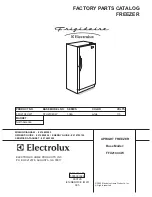
7
CLEANING AND CARE
** It is recommended to switch off the freezer at the socket outlet and pull out the power plug before cleaning.
** Never use any sharp abrasive instrument, soap, household cleaner, detergent and wax polish for cleaning.
** Use lukewarm water to clean the cabinet of the freezer and wipe it dry.
** Use a damp cloth soaked with a solution of one teaspoon of bicarbonate of soda to one pint of water to clean
the interior and wipe it dry.
** Excess deposits of ice should be removed on a regular basis using a plastic ice scraper available from your
local store. Large accumulations of ice will impair the performance of the freezer.
** If the freezer is not to be used for a long period of time, switch it off, remove all food, clean it and leave the lid
ajar.
** Check lid seals regularly to ensure they are clean and free from food particles.
Important Notes:
Never use water to wash the compressor position; wipe it with a dry cloth thoroughly after cleaning to prevent
rust.
DO’S AND DON’TS
Do
–
Defrost food from the freezer thoroughly in a fridge or in a microwave oven by following the defrosting and
cooking instructions.
Do
–
Ensure that chest freezer lid is completely closed after each use.
Do
–
Defrost frozen meat completely before cooking.
Do
–
Close the lid gently.
Do
–
Check contents of the freezer at regular intervals.
Do
–
Clean and defrost your freezer regularly (See “Defrosting”)
Do
–
Keep food for as shor
t a time as possible and adhere to “Best Before”, “Use By” dates.
Do
–
Store commercially frozen food in accordance with the instructions given on the packets that you buy.
Do
–
Always choose high quality fresh food and be sure it is thoroughly clean before you freeze it.
Do
–
Prepare fresh food for freezing in small portions to ensure rapid freezing.
Do
–
Wrap all foods in aluminum foil or freezer quality plastic bags and make sure any air is excluded.
Do
–
Wrap frozen food when you buy it and put it in to the freezer as soon as possible.
Do
–
Store small items in the basket provided.
Do
–
Remove ice cream from the freezer 10-20 minutes before serving.
Don’t –
Leave the lid open for long periods as this will make the freezer more costly to run and cause excessive
ice formation.
Don’t –
Use pointed sharp edged objects such as knives, forks to remove the ice.
Don’t –
Put hot food in the freezer. Let it cool down first.
Don’t –
Put liquid-filled bottles or sealed cans containing carbonated liquids into the freezer as they may burst.
Don’t –
Store poisonous or dangerous substances in the freezer. Your freezer has been designed for the storage
of edible foodstuffs only.
Don’t –
Consume ice-cream and water ices direct from the freezer. The low temperat
ure may cause ‘freezer
burns’ on lips.
Don’t –
Freeze fizzy drinks.
Don’t –
Try to keep frozen food which has thawed, it should be eaten within 24 hours or cooked and refrozen.
Don’t –
Remove items from the freezer with wet hands.
Don’t –
Shut the lid with force. You will damage the appliance.
• This appliance is not intended for use by persons
(including children) with reduced physical, sensory or mental capabilities,
or lack of experience and knowledge, unless they have been given supervision or instruction concerning use of the
appliance by a person responsible for their safety.
• Children should be supervised to ensure that they do not play with the appliance
.
• Do not store explosive substances such as aerosol cans with a flammable propellant in th
is appliance.
• If the supply cord is damaged, it must be replaced by
the manufacturer, its service agent or similarly qualified persons in
order to avoid a hazard.
ELECTRICAL INFORMATION
THIS APPLIANCE MUST BE GROUNDED.
This appliance is fitted with a fused three pin plug to BS 1363 which will be suitable for use in all houses fitted
with sockets to current specifications.
If the fitted plug is not suitable for your socket outlets, it should be cut off and carefully disposed of. To avoid a
possible shock hazard, do not insert the discarded plug into a socket.
:






























